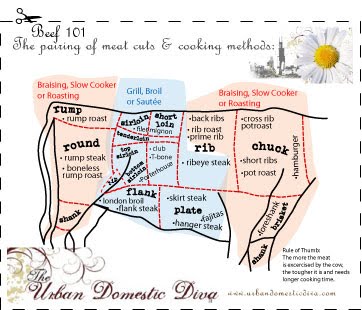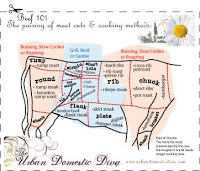
I have felt the need to do this post for a while. I am constantly dismayed when I am at the grocer when talking to the “butcher”. I put the word “butcher” in quotes because these guys that are hired by the grocery chains are far from a real butcher. Their lack of knowledge when asking them anything is shocking. I often need a certain cut of beef for a recipe, and they typically do not have it. When I ask for a worthy substitute, 9 times out of 10 they lead me astray. When I cook the substitute meat, it is tough and should not have been cooked the way I was planning on cooking it. I find this very frustrating after all the work I put into a meal.
The next recipe I plan on posting is a slow cooker recipe that I made last week. When I went to our European market to get the beef, they did not have the specific cut I needed. When I asked the butcher (I had higher hopes at this market versus the huge chains that these men knew more) he pointed to sirloin tip and waved at the surrounding cuts of sirloin and said that all that would work in the slow cooker. Now I vaguely remember being told this before and having a disastrous slow cooker meal-so I called my husband (one of his clients for years was The Beef Council) and as I read off the different cuts they had available, he weighed in on each. I am happy to report that the choice of chuck pot roast was perfect and so was the meal! So, I have decided to help all of us “beef challenged” grocery shoppers with a rundown of what cuts work for what kind of cooking-and I have created a printable card you can cut out and keep in your wallet or purse for shopping excursions. This will come in handy when your store will inevitably not have the cut you need and you will need a worthy substitute. Before I get to the nitty-gritty, I have to couch my criticism of butchers. It is not the butchers I am frustrated with. A real butcher, like the fine men at The Paulina Meat Market for instance (a Chicago pantheon of all things meat-https://www.paulinameatmarket.com) is a real treasure and if you have a real, local butcher please support them with your patronage. There are so few left. What we have for the most part are pretend butchers that the large grocery chains employ en masse. If these guys would educate themselves a little better, they would be a great asset to these chains and to their patrons.
As you can see above from the beef chart, the areas that get more activity or “exercise” are tougher cuts and need more time to cook. The areas in the middle like sirloin or filet will be very tender and need little time to cook. Also, it depends on the cut itself. The pieces with bone and sinew need a little more time to get tender with cooking while a chop or a steak doesn’t need nearly as much. Rolled roasts or roasts with a layer of fat on the outside make for great roasting or braising. The layer of fat keeps things moist and tender during the slower cooking time. Very “boney” pieces like ribs, shanks, oxtail and cheeks also need a lot of cooking time on account of the bones, sinew and tendons. But these cuts, if cooked properly, can yield some delicious nibbles of meat. Osso bucco, braised then grilled ribs or oxtail soup come to mind.
For more information, go to the consumer side of the National Cattlemen’s Beef Association at https://www.beefitswhatsfordinner.com/.
- Sugar-Free, Low-Carb, Olive Oil Chocolate Hazelnut Tart - February 18, 2023
- Easy Slow Cooker French Onion Soup - November 28, 2022
- Recipe: Chicken Vindaloo with Whole Foods Vindaloo Curry Powder - January 22, 2022




